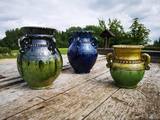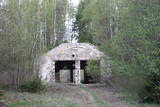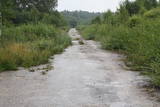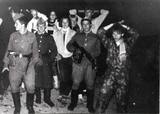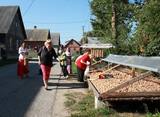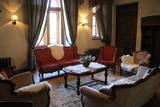| Nr | Nosaukums | Apraksts |
|---|---|---|
|
Vienīgais Alūksnes novada keramikas amata meistars, kurš veido Vidzemei raksturīgās podniecības formas ar Latgales krāsu gammu. Darbnīcā ir iespēja iepazīties ar keramiķa darbiem un ieklausīties stāstos par pirmajiem darinājumiem. Katrs interesents varēs atklāt sevī jaunas prasmes un talantu, līdzdarbojoties māla veidošanā, apgleznošanā un dedzināšanā. Darbnīcā iespējams iegādāties keramiķa darinātos māla izstrādājumus. Uģis Puzulis ir saņēmi kultūras zīmi “Latviskais mantojums”- par podniecības kā tradicionālas amata prasmes daudzināšanu. |
||
|
Viena no Latvijas skaistākajām upju krasta promenādēm, kas atrodas Ventas lejtecē – Ventspils vecpilsētas ziemeļdaļā. Tā izdekorēta ar govju skulptūrām, pieminekļiem, strūklakām un ziedu kompozīcijām. Šī ir viena no populārākajām pilsētnieku un tās ciemiņu pastaigu vietām, no kuras paveras pilsētas ostas skati. Līdz pagājušā gadsimta vidum Ostas ielā atradās noliktavas jeb tā saucamie spīķeri, no kuriem daļa ir saglabājusies līdz mūsdienām. Ostas ielas promenādes sākumu tās austrumdaļā iezīmē Tirgoņu dārzs (pie tā meklējams Ventspils TIC) un Jūrakmens. |
||
|
Dubīsas reģionālais parks (Dubysos regioninis parkas) dibināts 1992. gadā. Veidots Dubīsas upes ainaviskās senlejas aizsardzībai. Dubīsa – viena no populārākajām Lietuvas ūdenstūristu upēm (liels kritums, straujteces, ainaviski krasti). Tas aptver iespaidīgo Dubīsas ieleju, kuras dziļums sasniedz līdz pat 40 m, bet platums – līdz puskilometram. Skaistās ielejas nogāzes pāršķeļ dziļās sānu pieteku gravas. Šeit sastopami tādi nozīmīgi un Eiropas mērogā aizsargājami biotopi kā sausi zālāji kaļķainās augsnēs, sugām bagātas ganības un ganību pļavas, kuras apsaimnieko vietējie mājlopi, mēreni mitras pļavas, veci un dabiski boreālie (ziemeļu) meži, nogāžu un gravu meži un ozolu meži. Šeit kopumā konstatētas 805 augu sugas, 922 dzīvnieku sugas, no kurām daudzas ir aizsargājamas un reti sastopamas Lietuvas un Baltijas mērogā. Šejienes neparastais dabas skaistums ir ietekmējis senās pagānu tradīcijas – Betīgalā (Betygala) dzīvojis pēdējais pagānu priesteris Gintautas, kuru sauca par krīvu krīvu (krivių krivaitis). Tā dēvēja senos baltu tautu galvenos priesterus. Slavenā lietuviešu dzejnieka Mairoņa (1862. – 1932.) sētā ir izveidots etnogrāfiskais muzejs. Parka apmeklētāju centrs atrodas Kaulakiai ciemā. |
||
|
Līdz 18. gs. šajā vietā bija koka baznīca, kamēr 1798. g. uzcēla mūra baznīcu, kas cieta 1. pasaules karā, bet 2. pasaules kara laikā to uzspridzināja. Tikai pusgadsimtu vēlāk - 1991. gadā tika uzsākti atjaunošanas darbi, kas joprojām turpinās. Tagad redzamais dievnams ir iepriekšējā līdzinieks. |
||
|
Unikāla dabas un kultūrvēsturiska teritorija starp Kaldabruņu – Bebreni un Dvieti. Senlejai cauri tek mazā Dvietes upīte, kas plūst cauri Skuķu un Dvietes ezeriem un senlejai pieguļošajām palieņu pļavām. Tās plūdu laikā darbojas kā sava veida Daugavas ūdeņu „uzkrājējs”, ātri uzņemot lielas palu ūdeņu masas, bet vēlāk tās lēnām atdod. Ūdeņainos pavasaros šeit redzamie skati nelīdzinās nekur Latvijā citur redzamajiem. Senlejas ūdens līmeņa svārstību īpatnības ir iemesls, kādēļ šī ir nozīmīga augu un putnu dzīves vieta gan migrāciju, gan ligzdošanas laikā. Teritorijas aizsardzības nolūkā ir izveidots Dvietes palienes dabas parks. Interesanti, ka augstākās vietas, kas palu laikā neapplūst, sauc par salām. Dvietes senlejā ir atrastas 15 iespējamās seno cilvēku (akmens, bronzas, dzelzs laikmeta) apmetnes un ļoti bagātīgs dažādu seno priekšmetu - savrupatradumu klāsts. Ir pamats uzskatīt, ka šī ir viena no senākajām un nozīmīgākajām cilvēka dzīves vietām tagadējā Latvijas dienviddaļā.
|
||
|
Atrodas 0,1 km uz dienvidiem no Grobiņas pilsdrupām, Grobiņas ūdenskrātuves (Ālandes upes uzpludinājums) labajā krastā. Sens kuršu pilskalns, pie kura konstatētas senpilsētas paliekas. Vēsturiskie avoti liecina, ka 1263. g. kurši pili bez cīņas atdeva Livonijas ordeņa bruņiniekiem nodedzināšanai. Grobiņa ir viena no vecākajām Latvijas apdzīvotajām vietām, jo laikā no 7. - 9. gs. (pēc citiem avotiem: 4. – 10. gs.) te atradusies lielākā zināmā skandināvu tirgotāju un karavīru kolonija tagadējās Baltijas teritorijā. Gotlandes un Zviedrijas ieceļotāji apmetni ierīkoja tajā laikā kuģojamās Ālandes upes labā krasta pakalnā – Skābaržkalnā. Uzskata, ka tieši šeit atradusies 9. gs. hronikās pieminētā kuršu Jūrpils (Seeburg). Vietvārda (Skābaržkalns) izcelsmi saistīta ar pilsētas nosaukumu, jo Kurzemē skābaržus savulaik dēvēja par grobiem. Pie pilskalna novietota informatīva zīme. Ar otru Ālandes krastu to savieno neliela koka pārceltuve. |
||
|
Lauku sēta ar pirti atrodas Merkys upes krastā, ciema nomalē meža tuvumā. Piedāvā programmu "Griķu ceļš no sēklas līdz galdam", iespējams nobaudīt tradicionālos ēdienus. Piedāvā arī nakšņošanu. |
||
|
Restorāns "Laivas" atrodas Jūrmalā, Lielupes krastā. Piedāvājumā mūsdienu Latvijas virtuves ēdieni, izmantojot vietējos produktus. Restorāna īpašais piedāvājums ir kūpinājumi, kas gatavoti, balstoties uz tradīcijām un gadiem krāto pieredzi. Restorāns ieguvis dažādus apbalvojumus, tai skaitā iekļauts prestižajā Nordic White Guide un Top 30 Latvijas Restorāni 2019. |
||
|
Atrodas Madonas centrā pie Mīlestības gravas. Piedāvā maltītes visām ēdienreizēm, ekonomiskais pusdienu piedāvājums. Vasarās – āra terase. Beķereja, smalkmaizītes. |
||
|
Atrodas Bauskas centrā, Kalna iela 6. Muzeja piedāvājumā ir ekspozīcija „Bauska laikā un cilvēki Bauskā 20 gs., pastaiga un atraktīvs piedzīvojums”. |
||
|
Grūti pieejamā un atrodamā vietā - dziļos Bārtas mežos izvietota bijusī Plāņciema raķešu bāze, īpašs bijušais PSRS militārais objekts. Milzīga teritorija ar atsevišķiem sektoriem, kurus savieno betonēti ceļi. Redzami arī raķešu palaišanas laukumi. Tā kā teritorija netiek apsaimniekota un tajā "darbojas" bebri, apkārtne pamazām pārpurvojas. Varēja būt iespaidīgs tūrisma objekts, ja par to tiktu domāts jau senāk. Bāzes objekti daļēji ir nojaukti būvmateriālu ieguvei.
|
||
|
Dienvidos no Gardenes padomju laikā atradās viens no lielākajiem Baltijas kara apgabala tanku poligoniem. Mūsdienās lielākā daļa poligona ir neapsaimniekota un aizaugoša teritorija, kurā saglabājušies atsevišķi ēku fragmenti vai drupas u.c. poligoniem raksturīgie elementi. No Dobeles – Annenieku ceļa uz poligonu atdalās betonēts armijas ceļš, kas ir lietojams arī mūsdienās. Interesanta ir arī Gardenes apbūve – ēkas un to plānojums. Gardenē tajā laikā dzīvoja padomju armijas karavīri un to ģimenes.
|
||
|
Saukts arī par Jēša vai Ieša ezeru. Salām bagātākais Latvijas ezers ar aptuveni 35 salām. Visvairāk salu ir ezera ziemeļaustrumu daļā, bet lielākā sala ir Lielā Lāču sala (45 ha), uz kuras pat savulaik atradusies viensēta. |
||
|
Atrodas galvenās Kuldīgas gājēju ielas – Liepājas ielas malā. Kafejnīca ar senām ēdināšanas tradīcijām. |
||
|
Padomju robežsardze Lapmežciemā (uz Lapmežciema un Ragaciema robežas) ieradās sešdesmito gadu vidū, bet pameta 1991. gadā. Šajā objektā strādāja ap 50 militārās personas. Ragaciemieši un militāristi rīkoja kopējus pasākumus, piedalījās dažādās svinībās. Vietējos iedzīvotājus satrauca tikai radars, ar kura klātbūtni saistīja dažādas ikdienas nebūšanas. 1991. gadā zenītraķetes demontēja un aizveda nezināmā virzienā. Līdz šodienai bijušajā armijas teritorijā saglabājusies daudzdzīvokļu dzīvojamā māja. |
||
|
Peipusa ezera piekrastē ir sastopami arī citi gar vienīgo ielu sarindoti ciemati – Kolkja un Varnja, kas izveidojās pirms vairākiem gadsimtiem, kad, glābdamies no Krievijas valdības vajāšanas, šeit patvērumu rada vecticībnieki. Kolkjā ir apmeklējams vecticībnieku muzejs (www.hot.ee/kolkjamuuseum) un Sūr-Kolkjas vecticībnieku lūgšanu nams. Ciemā darbojas vecticībnieku baznīca un Varnjas Dzīvās vēstures muzejs (www.starover.ee). Muzeja eksponāti uzskatāmi stāsta par Peipusa vecticībnieku dzīves stilu vairāk nekā 350 gadus ilgā laika posmā. |
||
|
Pils tika būvēta tā, lai būtu gandrīz kopija Vindzoras pilij Anglijā. Šī ir viena no neierastākajām muižām Igaunijā. Tā ir tikpat interesanta kā tās īpašnieks - Frīdrihs fon Bergs. Aiz pils ir dendrārija parks ar reti sastopamām sugām. |
||
|
Atrodas Aknīstē, Skolas un Miera ielu krustojumā. Muzejs dibināts 1988. gadā. Tajā glabājas arheoloģiskais un etnogrāfiskais materiāls, kas raksturo Aknīstes un tai pieguļošās teritorijas attīstību no akmens laikmeta līdz pat mūsdienām. Muzejā apskatāma senlietu (akmens, bronzas laikmeta) kolekcija un priekšmeti, kas vēsta par apkārtnes ievērojamiem ļaudīm un sēļu kultūru. Apskates vērta ir seno sēļu trauku kolekcija. |
||
|
Bārs "Ratnīca" atrodas atjaunotajā Smuku muižas (no 16. gs.) kompleksā. Vasarās maltīti var baudīt uz viesu nama „Zirgu stallis” terases, ziemas mēnešos – pie kamīna bārā. Latviešu virtuve: „Kurzemnieku palaunadzis” (piena klimpu zupa ar žāvētu speķi), uz oglēm cepta siļķe, rupjmaizes kārtojums ar putukrējumu, „Piena rausis pa lauku modei” (pirmpiens, cukurs, kanēlis, dārza ogu mērce), siera kartupelis ar medū ceptu cūkgaļas cepeti. |
||
|
Arī 18. novembra laukums. Tas sācis veidoties 18. gadsimtā kā tirgus laukums. Tā dominantes bija 1752. g. celtais rātsnams (nav saglabājies) un aptieka, kas šajā ēkā darbojas no 1810. g. līdz pat mūsdienām. 2010. gadā laukumā izveidota strūklaka, kam ir pilsētas ģerboņa forma. |
||
